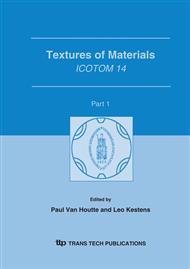p.1383
p.1389
p.1395
p.1401
p.1407
p.1413
p.1419
p.1425
p.1431
Effect of Hot Working on the Microstructure and Thermoelectric Characteristics of (Bi, Pb)-(Sr, Y)-Co-O Oxide
Abstract:
Thermoelectric oxides consisting of Bi, Pb, Sr, Y and Co are produced by usual sintering method. Uniaxial compression deformation is performed on the oxides under various deformation conditions. Melting temperature is determined by thermal analysis and deformation is conducted close to the melting point. After deformation, density, microstructure, texture and thermoelectric characteristics are experimentally examined. It is found that the oxides plastically deforms at high temperatures, resulting in an increase in density as well as the development of textures. The sharpness of the texture varies depending on deformation temperature, strain rate and the amount of strain. Microstructure observation by SEM elucidates that plastic deformation proceeds without generating severe cracks and all the grains are heavily deformed. Simple examination on the crystal structure suggests that perfect dislocation having small Burgers vector can move on {001} which coincides with the texture results.
Info:
Periodical:
Pages:
1407-1412
Citation:
Online since:
September 2005
Authors:
Price:
Сopyright:
© 2005 Trans Tech Publications Ltd. All Rights Reserved
Share:
Citation:


